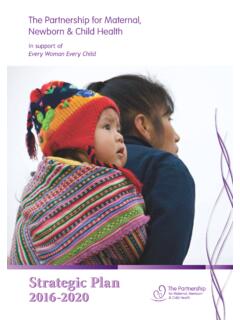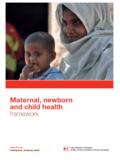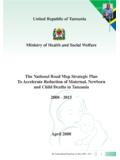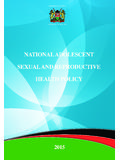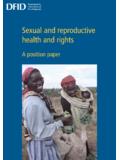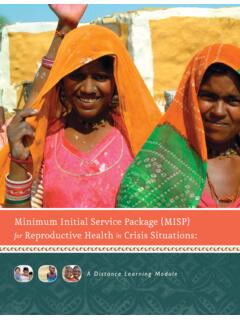Transcription of Male involvement and utilization of maternal health ...
1 International Journal of Scientific and Research Publications, Volume 4, Issue 11, November 2014 1 ISSN 2250-3153 Male involvement and utilization of maternal health services in India Kumar Chiman Sinha PhD Scholar, International Institute for Population Sciences, Mumbai-400088 Abstract- The present paper examines the association between the men s knowledge regarding the maternal health service utilization and maternal health in India using data from National Family health Survey 2005-06. The indicator of maternal health used in the analysis is safe delivery. Binary and multinomial logistic regression are used established the said association. Males involvement coded into two ways and two categories viz father present at the time of ANC visit or not, and whether at any time during the pregnancy any health provider or health worker told them about the various sign of pregnancy complications or not.
2 The other independent variables used in this analysis are age, children ever born, work status of the women, education of the women, religion and caste. The findings clearly suggest that male involvement and their knowledge about maternal health significantly associated with the maternal health . Those women s husband has knowledge regarding maternal health and those are present at the time of ANC visit more likely to utilize safe delivery service. Index Terms- maternal health , Male involvement , ANC, Institutional delivery I. INTRODUCTION uring the last few decades India has been going through an intensive transformation process related to changes in demographics and in the use of human capital. Among the most significant transformations, we find changes in family structure and fertility, a transition from a relatively young to a relatively older population, an increase in the labor force participation of women, and growth in levels of educational attainment.
3 There have been important changes in family size related to demographic transition. The total fertility rate fell from in 1998-99 to, to in 2005-06(NFHS-3). The evolution of family structure has also undergone important although somewhat less dramatic changes. Compared with other South Asian, a large percentage of Indian households are composed of nuclear families. The proportion of female-headed households has also increased. It is additionally worth mentioning that the majority of these demographic and socioeconomic changes started from the mid-1990s as a consequence of various policies implemented by the government, as well as some institutional changes. While it is true that the decline in India s fertility was already following a secular trend, public policy was additionally trying to accelerate this momentum. In 1996, safe motherhood and child health services were incorporated into the Reproductive and Child health Programme (RCH).
4 To improve the availability of and access to quality health care, especially for those residing in rural areas, the poor, women, and children, the government recently launched the National Rural health Mission for the 2005-2012 periods. In spite of the government s effort to reach out to pregnant women in all parts of the country to provide all components of maternal health care free or with nominal charges, utilization of maternal health care remains low in the country. For example, institutional delivery according to NFHS-2 was as low as 34 percent (IIPS, 2000). However, one of the important policy goals of the government is to achieve 80 percent institutional deliveries by the year 2010 (National Population Policy 2000). Though the government is committed to provide extensive free maternal health care under its top priority national health program, its low utilization is intriguing.
5 utilization of maternal health care depends not only on the availability of services but also on different other factors such as distance of health care facility; perception of women and husband and their families regarding the need for care; social restrictions on freedom to movement; the opportunity cost of accessing health care; and the interaction between the client and the provider of formal health care system (World Population Monitoring, 1998; IIPS, 2000). Also as a woman's social status and her health are intrinsically related, her low status often is the cause of poor access to essential healthcare (Report on Safe Motherhood Conference, 1987; Royston et al, 1989). II. LITERATURE REVIEW Women s house hold position is one of the important determinants of their health care utilization . It depends on many things, mainly the closeness of the husband-wife bond and the degree of communication between spouses have also been suggested to be an important dimension of women's household position (Jejeebhoy S 1995), because conjugal intimacy is generally discouraged in South Asia and the husband represents a direct avenue to household resources.
6 It is widely asserted that increased gender equality is a prerequisite for achieving improvements in maternal health . The Programme of Action adopted at the 1994 International Conference on Population and Development claimed that "improving the status of women also enhances their decision-making capacity at all levels in all spheres of life, especially in the area of sexuality and reproduction"(ICPD). Also, women s paid employment could alter the perception of women s value and motivate investment in the girl child s education and health (United Nations, 1999). D International Journal of Scientific and Research Publications, Volume 4, Issue 11, November 2014 2 ISSN 2250-3153 The investment of power on a woman becomes evident through her participation in household decision making, financial autonomy and freedom of movement (Kishor, 2004).
7 Lack of decision making power by a woman could result into lesser timely health seeking behaviour and leads to greater adverse health consequences (Sundari, 2004). The input of empowerment also has to enhance her intrinsically by changing her attitude or ideology into egalitarian ideas, otherwise the power or autonomy she has gained, could not channel her to make welfare and developmental decisions. A fundamental shift in perceptions, or inner transformation, is essential to the formulation of developmental choices (Malhotra A, 2002). Non-egalitarian gender relations deny woman an egalitarian decision making role during health care need, and other family matters (Jeejebhoy, 1998). Positive change in the attitude could alter the current submissive image of an Indian woman as only a reproductive tool, homemaker, caregiver and subordinate.
8 III. SOME IMPORTANT ASPECT OF maternal health CARE maternal health Care Services Primary maternal health care is provided by the government through health centers and sub health -centers. At the secondary level, there are district hospitals or community health centers and at the tertiary level, there are, regional and central hospitals. The government currently considers the numbers of facilities offering specialized maternal , newborn and child health care to be adequate, but recognizes a need to strengthen capacity, especially in terms of quality of care and management. It is government policy to provide antenatal care free of charge, except for medicine. Essential maternal care All women need of additional care during her pregnancy. All women must be given Tetanus Toxoid immunization and the full course of Iron Folic acid (IFA) tablets. All women need to be advised on the preparations they must take for delivery.
9 It is important that all pregnant women are registered early during pregnancy. The urgency for doing so must be emphasized by the premedical staff. The number of women registered sub-center wise should be monitored monthly. The annual estimated number of pregnant women must be worked out sub-center wise and the total number in the primary health center (PHC) area can be added up. The estimated number of pregnancies and the registered should be monitored to determine how many women are not receiving the essential services. The purpose of antenatal checkup is to monitor the progress of pregnancy and identify and treat medical complications early. Women who have no antenatal examination are at risk as they may have and underlying complications or high risk factor. Some women can even develop complication without warning. It is essential therefore that all pregnant women receive antenatal care and advise on where they deliver.
10 Need of the study Decision making and the utilization of health care facility are inseparable part of our analysis. Husband and wife as a couple bear all the responsibility of their present and future life. They have needed better understanding to successfully run their family. To live a peaceful life both have needed a good health . As our society s concern husband are always responsible to take all the decision regarding any expenses. To ensure good health husband and wife needs better cooperation. At the time of pregnancy demand for cooperation is more to ensure the safety of mother and child. So we have need to check the husbands presence at the time of wives ANC visit has any influence on better health care utilization as full ANC and a increase or decrease of institutional delivery. IV. OBJECTIVE OF THE STUDY Our specific objective of this study is- To examine husbands attitude and involvement in maternal health care utilization .










